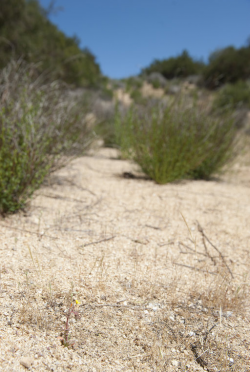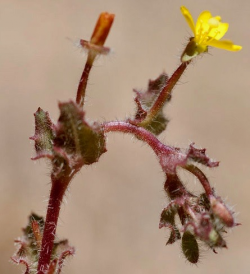
endangered

Hardham's evening-primrose (Camissoniopsis hardhamiae) in coarse-sandy opening in chaparral; plants scattered throughout area, generally in fruit at time of photo; associated with C. intermedia. North of Highway 58, San Luis Obispo County, CA, 16 April 2013. Copyright © 2013 Chris Winchell.

Hardham's evening-primrose (Camissoniopsis hardhamiae) in coarse, sandy soil. North of Highway 58, San Luis Obispo County, CA, 16 April 2013. Copyright © 2013 Chris Winchell.

Hardham's evening-primrose (Camissoniopsis hardhamiae), plant. North of Highway 58, San Luis Obispo County, CA, 16 April 2013. Copyright © 2013 Chris Winchell.

Hardham's evening-primrose (Camissoniopsis hardhamiae), inflorescence. North of Highway 58, San Luis Obispo County, CA, 16 April 2013. Copyright © 2013 Chris Winchell.

Hardham's evening-primrose (Camissoniopsis hardhamiae), fruiting individual. North of Highway 58, San Luis Obispo County, CA, 16 April 2013. Copyright © 2013 Chris Winchell.



This fact sheet was prepared by Dylan M. Neubauer under award NA04N0S4200074 from the National Oceanic and Atmospheric Administration (NOAA), U.S. Department of Commerce (DOC). The statements, findings, conclusions, and recommendations are those of the authors and do not necessarily reflect the views of the NOAA or the DOC.
© Copyright 2006, Elkhorn Slough Coastal Training Program
Last updated: Nov 28, 2017 18:36
Common Names - Hardham's evening-primrose
Family - Onagraceae (Evening-primrose Family)
State Status - none
Federal Status - none
Habitat
Disturbed or burned areas in chaparral and oak woodland; in sandy soil and decomposed carbonate; 140–945 m (CNPS 2012, CNDDB 2017).
Key Characteristics
Robust, rosetted, self-pollinating annual herb (hexaploid, 2n = 42) with spreading hairs, in inflorescence also glandular; stems erect, < 6 dm tall; leaves 1–12 cm long, cauline widely lanceolate to narrowly ovate, minutely dentate, ± sessile; hypanthium 1.7–2 mm long; sepals 1.8–3.2 mm long; petals 2–4 mm long, basal spots 0; 70–100% of pollen grains 4–5-angled; capsules 13-25 mm long, 1.3–1.6 mm wide, ± cylindric, drying ± 4-angled, straight to 1-coiled; seeds 0.7–1.1 mm long (Wagner 2012).
Camissoniopsis hardhamiae grows sympatrically with diploids (2n = 14) C. micrantha and C. hirtella, but the latter two taxa have < 5% of pollen grains 4–5-angled (Wagner 2012).
Flowering Period
March to May
Global Distribution
This central California endemic is limited to the South Coast Ranges in Monterey and San Luis Obispo counties.
Reference Population
Hi Mountain Lookout, Los Padres National Forest (San Luis Obispo County).
Discussion
Camissoniopsis hardhamiae (= Camissonia h. P. H. Raven) was described by Peter Raven in 1969, based on a 1963 type collection from Calf Canyon/Highway 58 in San Luis Obispo County (Raven 18315; CCH 2017). The species epithet honors Clare B. Hardham, a Paso Robles botanist who collected widely in the South Coast Ranges in the 1950s and 1960s. Hardham had collected the new taxon in Monterey County (Sandy Valley, 10035A) and San Luis Obispo County (2293) (CCH 2017). Raven (1969) hypothesized that C. hardhamiae was probably derived from C. micrantha x C. intermedia (2n = 28), two widespread species (Raven 1969, Wagner 2012).
The 2007 recircumscription of the genus Camissonia using molecular data (Wagner et al.) was a significant departure from Raven’s 1969 treatment, and the genus now includes only 14 species/17 taxa. Mostly endemic to the California Floristic Province, Camissonia probably diverged from its closest relative ca. 10 million years ago. Camissoniopsis hardhamiae is one of three hexaploids (along with C. luciae and C. robusta) (Wagner et al. 2007).
In some areas, plants appear to be associated with some degree of disturbance (CNDDB 2017).
Conservation and Threats
Camissoniopsis hardhamiae is known from 22 occurrences, seven of which are in Monterey County, while the remaining 15 are in San Luis Obispo County. In SLO, eight occurrences are on private land, while five have ownership unknown. Threats on these occurrences include road and infrastructure construction/maintenance, grazing, mining, erosion, and trampling. A SLO occurrence on Bureau of Land Management property near Santa Margarita Lake has not been relocated since 1986; surveys are required. The single SLO occurence on Los Padres National Forest land is located on Hi Mountain, and this location, too, requires surveys (CNDDB 2017).
In MNT, two occurrences are on private land and one has ownership unknown. The Sandy Valley occurrence (ownership unknown) based on Hardham’s 1962 collection on dolomite has not been relocated, nor has a Hames Valley occurrencce based on a 2005 specimen. Two Sargent Valley/Indian Valley-area occurrences contained thousands of plants in 2007. Two Fort Hunter-Liggett occurrences contained < 250 plants each in the mid-1990s. Threats there include military activities, road and infrastructure construction/maintenance, grazing, and feral pigs. The single Camp Roberts occurrence was likely extirpated in 2010 by herbicide use (CNDDB 2017). A possible Fort Ord National Monument occurrence, which would constitute a range extension, requires further investigation (D. Styer, personal communication, CCH 2017).
As this species favors disturbance, more surveys are required to determine its full extent and status. As populations tend to be small, random, stochastic events are a threat (USFS 2004).
References
California Native Plant Society (CNPS), Rare Plant Program. 2012. Camissoniopsis hardhamiae. Inventory of Rare and Endangered Plants (online edition, v8-03 0.39). California Native Plant Society, Sacramento, CA. http://www.rareplants.cnps.org/detail/380.html [acc. 27 November 2017].
California Natural Diversity Database (CNDDB). 2017. [Internet]. California Department of Fish and Wildlife [acc. 25 November 2017].
Consortium of California Herbaria (CCH). 2017. [Internet]. [acc. 27 November 2017].
Haydu, K. 2012. Mapping plant biodiversity hotspots at the county scale: a new tool for establishing resource conservation strategies. Master's Thesis, California Polytechnic State University, San Luis Obispo, CA. http://digitalcommons.calpoly.edu/cgi/viewcontent.cgi?article=1792&context=theses [acc. 28 November 2017].
Hoover, R. F. 1970. The vascular plants of San Luis Obispo County, California. University of California Press, Berkeley, CA.
Los Padres Forest Watch. 2017. Hardham’s Evening Primrose: Camissoniopsis hardhamiae. http://lpfw.org/our-region/wildlife/hardhams-evening-primrose/ [acc. 28 November 2017].
Matthews, M. A. and M. Mitchell. 2015. The plants of Monterey County: an illustrated field key, 2nd edition. Monterey Bay Chapter, California Native Plant Society, Carmel, CA.
Raven, P. 1969. A revision of the genus Camissonia (Onagraceae). Contributions from the United States National Herbarium 37(5):161–396.
Stephenson, J. R. and G. M. Calcarone. 1999. Southern California mountains and foothills assessment: habitat and species conservation issues. General Technical Report GTR-PSW-172. USDA Forest Service, Pacific Southwest Research Station, Albany, CA.
Styer, D. 2017. Author, unpublished flora of Fort Ord, personal communication.
USDA Forest Service (USFS). 2004. Camissonia hardhamiae. SoCalBiodiversity-Plants (species descriptions). https://www.fs.usda.gov/Internet/FSE_DOCUMENTS/stelprd3832682.pdf [acc. 25 November 2017].
Wagner, W. L. 2012. Camissoniopsis hardhamiae, in Jepson Flora Project (eds.) Jepson eFlora, http://ucjeps.berkeley.edu/eflora/eflora_display.php?tid=89200 [acc. 27 November 2017].
Wagner, W. L., P. C. Hoch, and P. H. Raven. 2007. Revised classification of the Onagraceae. Systematic Botany Monographs 83:1–240.
